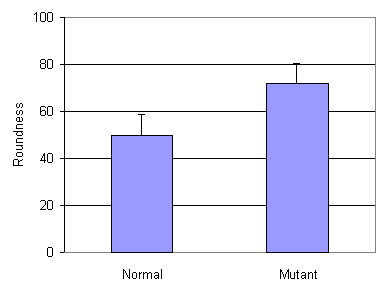
MAINTENANCE OF CELL SHAPE
Introduction: Fibrous elements of the cytoskeleton, including microtubules and filaments, help maintain cell shape. For example, amoeba movement involves interactions of myosin and actin in the microfilaments in the cell cytoskeleton. Myosin is normally dispersed throughout the cell, but locally assembles and disassembles as necessary to drive movement.
Importance: The importance of myosin to cell translocation can be assessed by studying shape differences between normal amoeba cells which assemble and disassemble myosin and mutant cells which overassemble myosin.
Question: How does the assembly of myosin contribute to cell shape?
Methods: One way to quantify cell shape is by measuring the roundness of cells. For cells with unusual shapes, it may be difficult to visually compare cell shape. Roundness can be quantified from two dimensional pictures of cells by comparing the area of a cell to its perimeter:

For a perfect sphere, the area and perimeter for a two dimensional picture of the cell are given by the usual formulas pr2 and 2pr. Therefore, for a spherical cell, roundness equals 100%. A straight line, which has no area, would have a roundness of 0%.
We can quantify the roundness of normal and mutant cells to assess how the overassembly of myosin affects cell shape. Two dimensional pictures of normal and mutant cells can be taken and the area and perimeter of cells measured.
|
|
Normal 1 |
Normal 2 |
Normal 3 |
Mutant 1 |
Mutant 2 |
Mutant 3 |
|
Area (micrometers2) |
96 |
111 |
89 |
66 |
57 |
60 |
|
Perimeter (micrometers) |
53 |
49 |
48 |
34 |
32 |
32 |
We can then calculate and graph the mean roundness for nomal and mutant cells in order to compare them.

Interpretation: Normal cells, which assemble myosin normally, are somewhat elongate and have roundness values averaging 49.8%. Mutant cells, which overassemble myosin, were found to have significantly higher roundness at approximately 71.7%.
Conclusion: The abnormally round shape of mutant cells may be due to the high level of tension in the cell due to the overassembly of myosin. In normal cells, moderate levels of myosin help maintain the elongate shape. By quantifying cell roundness, we can assess the affects of myosin assembly on cell shape.
Additional Questions:
1. Calculate the roundness for each of the 6 cells given in the table.
2. What would the roundness be for a cell that was shaped like a cube?
Source: Stites, J., D. Wessels, A. Uhl, T. Egelhoff, D. Shutt, and D. R. Soll. 1998. Phosphorylation of the Dictyostelium myosin II heavy chain is necessary for maintaining cellular polarity and suppressing turning during chemotaxis. Cell Motility and the Cytoskeleton 39:31-51
Copyright 1999 M. Beals, L. Gross, S. Harrell